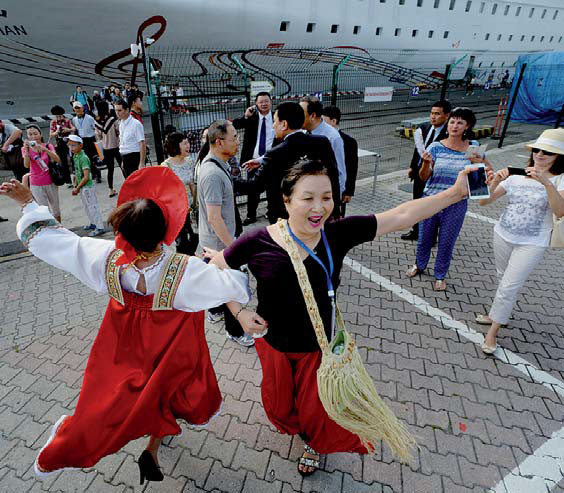Cruises could be just the ticket for reviving ports
Southern China's ports are striving to develop a cruise industry as a new driver to expand their economies, but experts say it is paramount for them to explore a new business model in their hunt for profits.
Prince Bay Cruise Homeport, in Shenzhen, Guangdong province, officially started operations on Nov 12, marking a milestone in the development of the city's cruise industry.
The first cruise liner to drop anchor was the SuperStar Virgo, owned by Genting Hong Kong - the leading global leisure, entertainment and hospitality company. It left on Sunday for a six-day trip to Vietnam with 1,445 passengers.
|
Chinese tourists on the cruise ship Taishan receive a robust welcome on arrival at the port of Vladivostok, Russia. Vitaliy Ankov / For China Daily |
The six-star Silver Shadow cruise liner is also expected to set sail from the port in January next year.
The port facility is wholly owned by Shenzhen-based and listed China Merchants Shekou Industrial Zone Holdings, a subsidiary of the state-owned conglomerate China Merchants Group.
The whole harbor district covers an area of 697,640 square meters, with a total building area of 1.7 million sq m. The biggest berth among its total of 15 can accommodate the world's biggest ocean liners.
CMSK says it is currently at the first stage of construction, and more berths will be established soon after getting approval from the government.
Meanwhile, Hong Kong and Guangzhou received one of the largest cruiseships in Asia - the maiden cruise of Dream Cruises, also operated by Genting Hong Kong, on the same day.
Experts say they believe the burgeoning cruise industry in China could revive sluggish port economies, but they say the key is to find a sustainable development model.
China's port industry is developing at a very slow speed, says Chen Yingming, deputy director of the China Ports and Harbors Association.
He says China's port throughput increased only 2.2 percent in the first nine months of 2016 over the same period last year- the lowest growth rate in the sector's history.
But the cruise industry, by contrast, is growing in double digits. China's 10 cruise ports received 629 cruises, and 2.48 million people sailed on cruises in 2015, up 35 and 44 percent respectively over the previous year, according to China National Tourism Administration data.
Chen says even with passenger volumes exploding, few of these 10 ports are making profits because the vessels were passing through the port but services were limited.
The traditional function of a port is for people and cargos to go in and out, but now a new innovative tourism product needs be developed, he says.
Xu Yongjun, general manager of CMSK, says the company is exploring a new strategy for port management, starting with the Prince Bay homeport in Shenzhen.
chaihua@chinadaily.com.cn



















